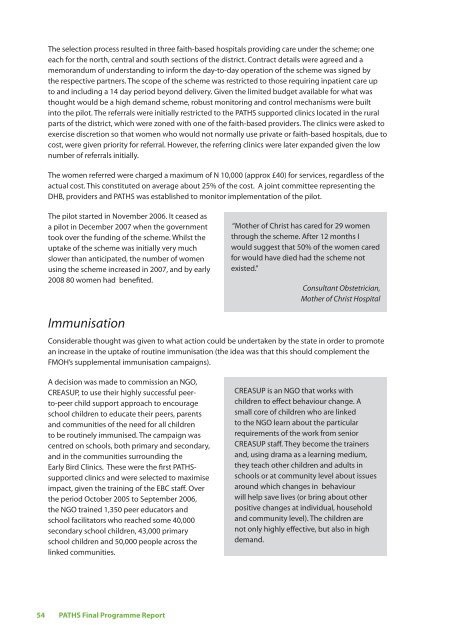PATHS Final programme report: "Togetherness in Health" the Enugu ...
PATHS Final programme report: "Togetherness in Health" the Enugu ...
PATHS Final programme report: "Togetherness in Health" the Enugu ...
Create successful ePaper yourself
Turn your PDF publications into a flip-book with our unique Google optimized e-Paper software.
The selection process resulted <strong>in</strong> three faith-based hospitals provid<strong>in</strong>g care under <strong>the</strong> scheme; oneeach for <strong>the</strong> north, central and south sections of <strong>the</strong> district. Contract details were agreed and amemorandum of understand<strong>in</strong>g to <strong>in</strong>form <strong>the</strong> day-to-day operation of <strong>the</strong> scheme was signed by<strong>the</strong> respective partners. The scope of <strong>the</strong> scheme was restricted to those requir<strong>in</strong>g <strong>in</strong>patient care upto and <strong>in</strong>clud<strong>in</strong>g a 14 day period beyond delivery. Given <strong>the</strong> limited budget available for what wasthought would be a high demand scheme, robust monitor<strong>in</strong>g and control mechanisms were built<strong>in</strong>to <strong>the</strong> pilot. The referrals were <strong>in</strong>itially restricted to <strong>the</strong> <strong>PATHS</strong> supported cl<strong>in</strong>ics located <strong>in</strong> <strong>the</strong> ruralparts of <strong>the</strong> district, which were zoned with one of <strong>the</strong> faith-based providers. The cl<strong>in</strong>ics were asked toexercise discretion so that women who would not normally use private or faith-based hospitals, due tocost, were given priority for referral. However, <strong>the</strong> referr<strong>in</strong>g cl<strong>in</strong>ics were later expanded given <strong>the</strong> lownumber of referrals <strong>in</strong>itially.The women referred were charged a maximum of N 10,000 (approx £40) for services, regardless of <strong>the</strong>actual cost. This constituted on average about 25% of <strong>the</strong> cost. A jo<strong>in</strong>t committee represent<strong>in</strong>g <strong>the</strong>DHB, providers and <strong>PATHS</strong> was established to monitor implementation of <strong>the</strong> pilot.The pilot started <strong>in</strong> November 2006. It ceased asa pilot <strong>in</strong> December 2007 when <strong>the</strong> governmenttook over <strong>the</strong> fund<strong>in</strong>g of <strong>the</strong> scheme. Whilst <strong>the</strong>uptake of <strong>the</strong> scheme was <strong>in</strong>itially very muchslower than anticipated, <strong>the</strong> number of womenus<strong>in</strong>g <strong>the</strong> scheme <strong>in</strong>creased <strong>in</strong> 2007, and by early2008 80 women had benefited.“Mo<strong>the</strong>r of Christ has cared for 29 womenthrough <strong>the</strong> scheme. After 12 months Iwould suggest that 50% of <strong>the</strong> women caredfor would have died had <strong>the</strong> scheme notexisted.”Consultant Obstetrician,Mo<strong>the</strong>r of Christ HospitalImmunisationConsiderable thought was given to what action could be undertaken by <strong>the</strong> state <strong>in</strong> order to promotean <strong>in</strong>crease <strong>in</strong> <strong>the</strong> uptake of rout<strong>in</strong>e immunisation (<strong>the</strong> idea was that this should complement <strong>the</strong>FMOH’s supplemental immunisation campaigns).A decision was made to commission an NGO,CREASUP, to use <strong>the</strong>ir highly successful peerto-peerchild support approach to encourageschool children to educate <strong>the</strong>ir peers, parentsand communities of <strong>the</strong> need for all childrento be rout<strong>in</strong>ely immunised. The campaign wascentred on schools, both primary and secondary,and <strong>in</strong> <strong>the</strong> communities surround<strong>in</strong>g <strong>the</strong>Early Bird Cl<strong>in</strong>ics. These were <strong>the</strong> first <strong>PATHS</strong>supportedcl<strong>in</strong>ics and were selected to maximiseimpact, given <strong>the</strong> tra<strong>in</strong><strong>in</strong>g of <strong>the</strong> EBC staff. Over<strong>the</strong> period October 2005 to September 2006,<strong>the</strong> NGO tra<strong>in</strong>ed 1,350 peer educators andschool facilitators who reached some 40,000secondary school children, 43,000 primaryschool children and 50,000 people across <strong>the</strong>l<strong>in</strong>ked communities.CREASUP is an NGO that works withchildren to effect behaviour change. Asmall core of children who are l<strong>in</strong>kedto <strong>the</strong> NGO learn about <strong>the</strong> particularrequirements of <strong>the</strong> work from seniorCREASUP staff. They become <strong>the</strong> tra<strong>in</strong>ersand, us<strong>in</strong>g drama as a learn<strong>in</strong>g medium,<strong>the</strong>y teach o<strong>the</strong>r children and adults <strong>in</strong>schools or at community level about issuesaround which changes <strong>in</strong> behaviourwill help save lives (or br<strong>in</strong>g about o<strong>the</strong>rpositive changes at <strong>in</strong>dividual, householdand community level). The children arenot only highly effective, but also <strong>in</strong> highdemand.54 <strong>PATHS</strong> <strong>F<strong>in</strong>al</strong> Programme Report





